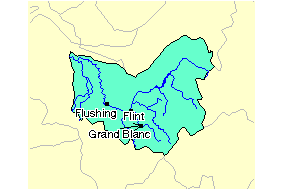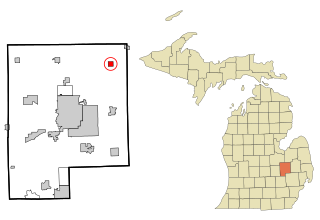
The Huckleberry Railroad is a 3 ft narrow gauge heritage railroad located in Genesee Township, Michigan, near Flint. The railroad operates alongside Crossroads Village, both of which are owned and maintained by the Genesee County Parks and Recreation Commission.

The Mid-Michigan Railroad is a railroad owned by Genesee & Wyoming. It operates 39.8 miles of track in Michigan.

The Chicago, Kalamazoo and Saginaw Railway (CK&S), known informally as the "Cuss, Kick & Swear" is a defunct railroad which operated in southwest Michigan in the late 19th and early to mid 20th centuries. Despite the name, the line ran entirely within the state of Michigan, with the majority in Kalamazoo County. It eventually became part of the New York Central. As of 2010, most of the former CK&S tracks have since been abandoned.
The Saginaw and Mount Pleasant Railroad was a wholly owned subsidiary of the Flint and Pere Marquette Railroad (F&PM). It was established to construct a 14.7-mile (23.7 km) railway line from a junction with the F&PM main line at Coleman, Michigan, to Mount Pleasant, Michigan. The line opened on December 15, 1879, as a 3 ft narrow gauge line. In mid-1884 the line was converted to 4 ft 8 1⁄2 instandard gauge. On January 31, 1889 the company was formally merged into the F&PM along with the East Saginaw and St. Clair Railroad, the Saginaw and Clare County Railroad, and the Manistee Railroad.
The Flint and Pere Marquette Railroad (F&PM) is a defunct railroad which operated in the U.S. state of Michigan between 1857 and 1899. It was one of the three companies which merged to become the Pere Marquette Railway.
The Flint and Holly Railroad (F&H) is a defunct railroad that operated in eastern Michigan from 1863 to 1868. It was founded by Henry H. Crapo, a Massachusetts-born lumber merchant who served as Governor of Michigan (1865–1869). The line was originally chartered as the Flint and Fentonville Railroad on January 3, 1863, and was amended on October 16, 1863. On November 1, 1864, the F&H completed a railway line from Flint, Michigan to Holly, Michigan. Via an agreement with the Detroit and Milwaukee Railway (D&M), F&H ran into Detroit's Brush Street Station over D&M tracks.
The Bay City and East Saginaw Railroad is a defunct railroad which operated in central Michigan before being bought by the Flint and Pere Marquette Railroad (F&PM). The company was chartered on April 8, 1864, and on November 1, 1867, completed a 13-mile (21 km) railway line from East Saginaw, Michigan to Bay City. In 1868 the F&PM leased the line; in 1872 it bought the company outright.
The Detroit, Lansing and Northern Railroad (DL&N) is a defunct railroad which was formed on December 27, 1876 as a reorganization of the foreclosed Detroit, Lansing and Lake Michigan Rail Road. The segment of its main line from Detroit to Lansing became an important component of the Pere Marquette Railroad, organized in 1900, and is still in use by CSX.
The Cass River Railroad is a defunct railroad which operated in Michigan during the early 1870s. The company was chartered on December 12, 1871. In 1872 it completed a 19.4-mile (31.2 km) line from East Saginaw to Vassar. The line was intended to exploit the timber resources in the Cass River area. On June 4, 1872, the company was bought by the Flint and Pere Marquette Railroad (F&PM).
The Manistee Railroad in Michigan was a wholly owned subsidiary of the Flint and Pere Marquette Railroad (F&PM). It was established on June 19, 1880, to construct a branch line from the F&PM's main line (Ludington–Monroe) at Walhalla to Manistee. The completion of this line in 1883 gave the F&PM access to Manistee's lake trade and local salt mining operations. The Manistee Railroad was consolidated with the F&PM on January 30, 1889.
The Saginaw and Clare County Railroad was a wholly owned subsidiary of the Flint and Pere Marquette Railroad (F&PM). It was chartered on September 4, 1877, to construct a branch line to Lake George, Michigan. On September 30, 1880, the company completed a 15.5-mile (24.9 km) branch line from Harrison Junction to Harrison. The line did not serve Lake George. In 1883 this line was extended north to Meredith, for a total length of 29.91 miles (48.14 km). The Saginaw & Clare County was consolidated with the F&PM on January 30, 1889.
The Chicago and West Michigan Railway (C&WM) is a defunct railroad which operated in the state of Michigan between 1881 and 1899. It was one of the three companies which merged to become the Pere Marquette Railway.
The Paw Paw Railroad is a defunct railroad which operated in Van Buren County, Michigan, between 1857 and 1887. At a length of 4 miles (6.4 km), it was the shortest operating common carrier railroad in the state. Later, the Ludington & Northern Railway Company, at 2.79 miles (4.49 km), stripped the Paw Paw of its title as "shortest Michigan Railroad".
The White River Railroad was a wholly owned subsidiary of the Chicago and West Michigan Railroad incorporated on November 13, 1879, for the purpose of constructing a rail link north from the C&WM's line at White Cloud to the Flint and Pere Marquette Railroad's main line (Ludington–Monroe) at Baldwin, and to exploit the ample timber resources of the White River area. On April 1, 1880, the White River opened a 13-mile (21 km) line from White Cloud north to Merrill Township, in Newaygo County. In 1881 the line was extended a further 4 miles (6.4 km) to what would become Bitely in 1889. In either late 1883 or no later than February 7, 1884, the White River completed the line all the way to Baldwin, for a total length of 29.86 miles (48.06 km).
The Grand Rapids, Kalkaska and Southeastern Railroad is a defunct railroad which operated in Northern Michigan toward the end of the 19th century. The company was founded on August 30, 1897 by William Alden Smith, a Republican politician and former general counsel of both the Chicago and West Michigan Railway and the Detroit, Lansing and Northern Railroad. The GRK&S constructed a 40.73-mile (65.55 km) line from northern Missaukee County through Kalkaska to Rapid City, where it met the C&WM's main line. The C&WM undertook to supply rolling stock and oversee construction in exchange for a 10-year lease of the line.
The Ionia and Lansing Rail Road is a defunct railroad which operated in the state of Michigan in the 1860s and 1870s. The company incorporated on November 13, 1865; the investors hailed primarily from Lansing, Ionia and Portland. The original charter called for a 34-mile (55 km) from Ionia to Lansing; on January 13, 1869 this was amended with a much grander vision: a 125-mile (201 km) line from Lansing to the mouth of the Pentwater River at Pentwater, on the shores of Lake Michigan.
The Toledo Division was the southern half of the Pere Marquette Railway's main line, which ran from Ludington, Michigan to Toledo, Ohio. The Toledo Division encompassed the portion which ran from Toledo north to Saginaw, Michigan, where it met the Ludington Division. The line was built by a predecessor of the PM, the Flint & Pere Marquette, and is currently owned by CSX Transportation.
Michigan United Railways (MUR) was an interurban which owned and leased numerous lines in the state of Michigan during the early twentieth century.
The Grand Rapids, Belding and Saginaw Railroad is a defunct railroad which operated in the state of Michigan at the turn of the 20th century.








